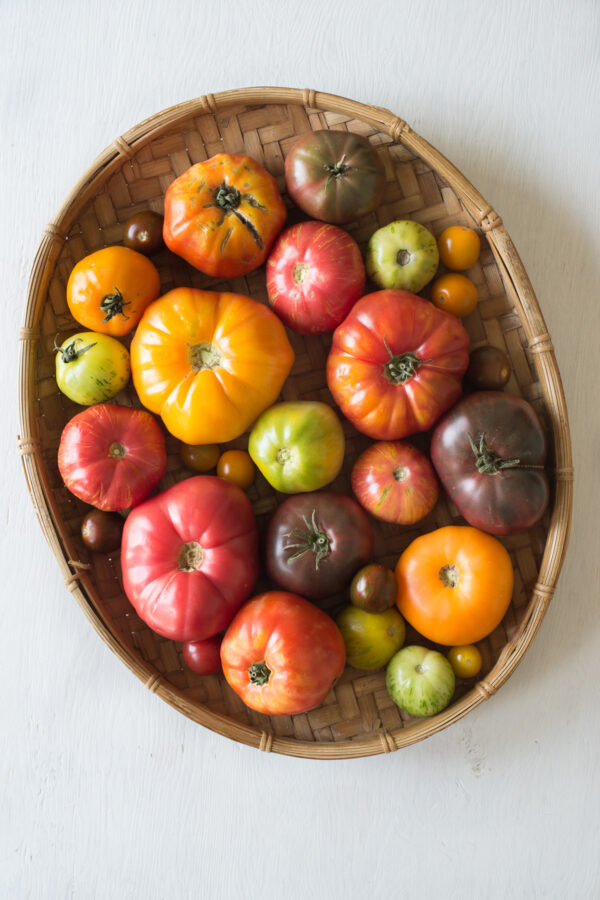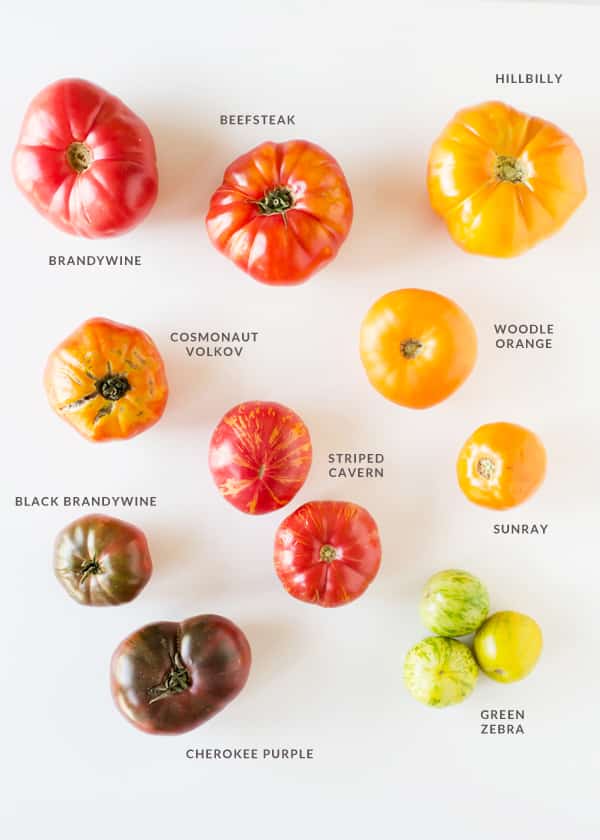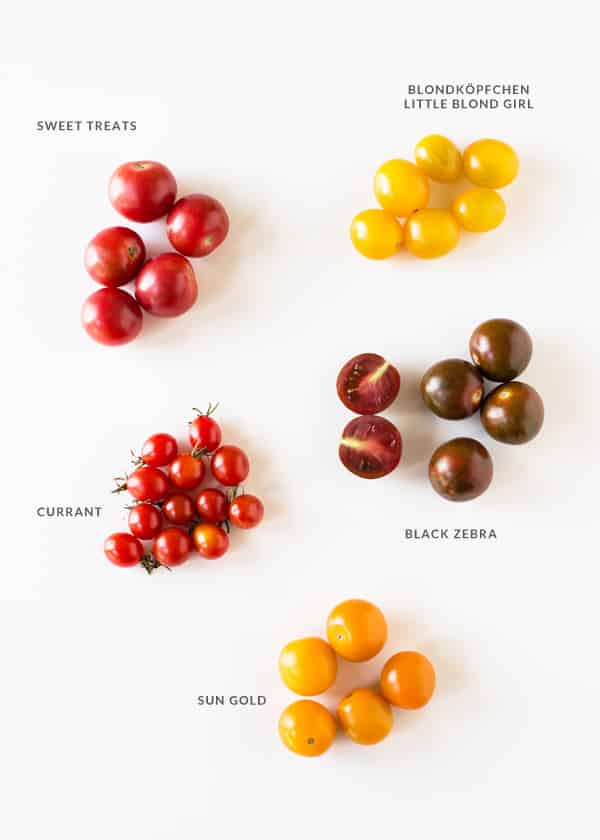 I'll let you in on a little secret: I never liked fresh tomatoes. Until, that is, I had my first heirloom tomato. You've probably had an heirloom tomato at least once or twice—you might even grow them in your garden or pick them up at the farmers market. They're everywhere in August; they make a great addition to nearly any dish, or a marvelous snack (or dinner) on their own. Here's everything you need to know about the best (edible) part of summer:
I'll let you in on a little secret: I never liked fresh tomatoes. Until, that is, I had my first heirloom tomato. You've probably had an heirloom tomato at least once or twice—you might even grow them in your garden or pick them up at the farmers market. They're everywhere in August; they make a great addition to nearly any dish, or a marvelous snack (or dinner) on their own. Here's everything you need to know about the best (edible) part of summer:
what does 'heirloom' even mean?
Heirloom, also called Heritage, refers to varieties of tomatoes whose seeds have been passed down for generations because of desired qualities and characteristics. Basically, they are older varieties (but not always!) of tomatoes that are prized due to their unique colors, flavors, textures and characteristics. Heirloom varieties are open-pollinated. You can save seeds from the heirloom tomatoes, plant them, and they will grown into new tomato plants. If two or more varieties are planted near each other, you never know—you might end up with a new mystery variety!
Heirlooms are classified into four specific categories:
Family Heirlooms: Seeds are gathered and passed down within a family through the generations.
Commercial Heirlooms: Varieties that were introduced before the 1940s, are open-pollinated and have been in circulation for more than 50 years.
Created Heirlooms: These tomatoes were created by hybridizing two known parents (either two heirlooms or an heirloom and a hybrid variety). The resulting seeds are dehybridized for several generations so that undesirable characteristics are eliminated, a process which can take eight to 10 years, or more.
Mystery Heirlooms: These varieties are created due to natural cross-pollination of heirloom varieties.
why are heirlooms so desirable?
Heirlooms usually haven't been hybridized for qualities that include shelf life, color and uniform appearance. They are often "ugly" with deep cracks and bumps. The colors are variegated and range from deep browns and purples to light yellows, pinks and everything in between. The only color I haven't seen is blue!
where can I buy heirloom tomatoes?
You will be able to find heirlooms at local farmers markets, and even some grocery stores. Because heirlooms are becoming more popular and in demand, they are more readily available than they once were. Whole Foods and Trader Joe's usually have heirlooms year-round, but they are obviously better in the summer during normal tomato season. Buy local if you can. Often CSAs will also include heirlooms during the summer.
how do you select a good heirloom tomato?
Selecting heirloom tomatoes is different than your regular, run-of-the-mill red tomato. The colors are only the beginning of it. Each variety is valued for its unique flavors and textures. (See below for more on that subject.)
The first rule of thumb when shopping for heirlooms is to handle them with extreme care. Touching the heirlooms is often discouraged; a squeeze will earn you the evil eye from your grocer. The skins of heirlooms are thinner, the flesh is more prone to bruising, and therefore they spoil more quickly. Just give them a once-over and make sure the skin is intact (cracks are okay, but avoid splits that are oozing tomato juice). Avoid overly ripe tomatoes, too—if you won't be using them the same day, buy some that are a little underripe.
When it comes to heirlooms, the uglier the better, I say. Cracks and bumps give them character.
how do you store heirloom tomatoes?
As I mentioned, heirlooms spoil very quickly. It's best to enjoy them within 1-2 days of buying them. If you need to keep them for longer, choose some that are a little firmer and underripe. They will continue to ripen at room temperature. Do not under any circumstances refrigerate the tomatoes. It will ruin their glorious texture and flavor. Keep them on the counter in an area where they won't be squished by other foods. To keep fruit flies away, cover them with a fine mesh sieve. Only once they've been cut should you store in the refrigerator.
why should you eat heirloom tomatoes?
Due to their lack of commercial hybridization, heirlooms are actually a little lower in lycopene than strictly red tomatoes. But they are full of vitamins A and C, minerals and fiber, and support cardiovascular and bone health. Not to mention they are life-changing in their sweet flavor and juicy, almost buttery texture.
what are the heirloom tomato varieties?
Too many to count! Here are some popular ones:
Big heirlooms:
- Brandywine: a variety of beefsteak, gorgeous deep pink-red color when ripe, intense tomato flavor
- Beefsteak: exceptional flavor and texture, one of the most popular varieties, great for slicing
- Hillbilly: a low-acid tomato originally from West Virginia, a variety of beefsteak, very good texture and flavor
- Cosmonaut Volkov: named after the first Russian cosmonaut, rich, deep flavor that is sweet and tangy
- Striped Cavern: some look almost like bell peppers, more hollow inside making them great for stuffing, excellent flavor
- Woodle Orange: tangerine color when fully ripe, complex flavor
- Sunray: mild, sweet and tangy flavor, great cooked into sauces or fresh
- Black Brandywine: deep, dark mahogany when fully ripe, unforgettable flavor
- Cherokee Purple: very dense, juicy texture
- Green Zebra: pleasant rich tomato flavor with a zingy or sharp "bite"
- Sweet Treats: gorgeous deep pink color when fully ripe, perfect balance of sweet and tart flavor
- Blondköpfchen (Little Blonde Girl): an East German heirloom with a very sweet flavor
- Currant: tiny, very sweet and juicy, bursting with flavor
- Black Zebra: dark, dark red with green stripes, great flavor with a firm texture, easy to cut
- Sun Gold: great for snacking, very sweet-tart flavor, flavorful even when not completely ripe
how do you prepare heirloom tomatoes?
Just as you would any tomato. They are at their best when eaten raw, but make glorious salsas, fresh or cooked pasta sauces, and fresh juice. Heirlooms can even be bottled or dehydrated to preserve a bountiful garden harvest. Get 15 gorgeous heirloom tomato recipes here!
This post was originally published on August 10, 2014.




Samantha @FerraroKitchen says
This post is like a dream come true!! I LOVE tomatoes..I mean LOVE them! Heirlooms make my heart go pitter patter and I can't get enough! Our neighbor has a tomato garden and always gives us some during the summer. So far I've made gazpacho, salads galore, tarts, galettes..and I still have a whole bowl to use. I've always said that my 1st cook book will be all about tomatoes..we'll see 😉
Laura (Tutti Dolci) says
Heirlooms are gorgeous and this guide is so helpful!
mjskit says
I'm with you - if you want to learn to love tomatoes, then eat an heirloom tomato. We are growing 3 different types of heirlooms this year - homestead, Golden Jubilees, and Black Prince (a large version of the Black Zebras. They are ALL awesome! I'm going to have look for some of the varieties that you mentioned above. I've never heard of Black Brandywine.
Krista @ Joyful Healthy Eats says
Loved this! Super helpful, can't wait to start picking some out .. and now I know how to do it without getting the evil eye. 🙂
Kate @¡Hola! Jalapeño says
What a great post and thank you for the map it so great to have a clear detail of what which is what!
Russell from Chasing Delicious says
What a fantastic post and resource! I now am craving a caprese salad that's mostly just a big stack of heirloom tomatoes.
Joanne says
I only buy heirloom tomatoes during the summer and they NEVER disappoint! Love that I can now put names to all the tomatoes I've been eating. Thanks for this informative post!
Jaime @ the Seasonal Veg Head says
This is a wonderful guide!! And beautiful photos! Pinning for sure! 🙂
Al | Saving the Crumbs says
I just happened across this post since my wife and I are trying to grow heirloom tomatoes in our garden for the first time this year. Appreciate this informative post--especially the succulent tomato photos!
Russell says
so I'm Got these two heirlooms That I bought as young plants. I'm now afraid the frost will take them. Can I ripen them in paper
Oh My Veggies says
You can let them ripen on your countertop at room temperature.
michelle says
HI!!!
What happens to freeze-dried fruits when you soak them or heat them?
Do they get awfully mushy?
Would it be better to just use dried fruit?
Thanks!